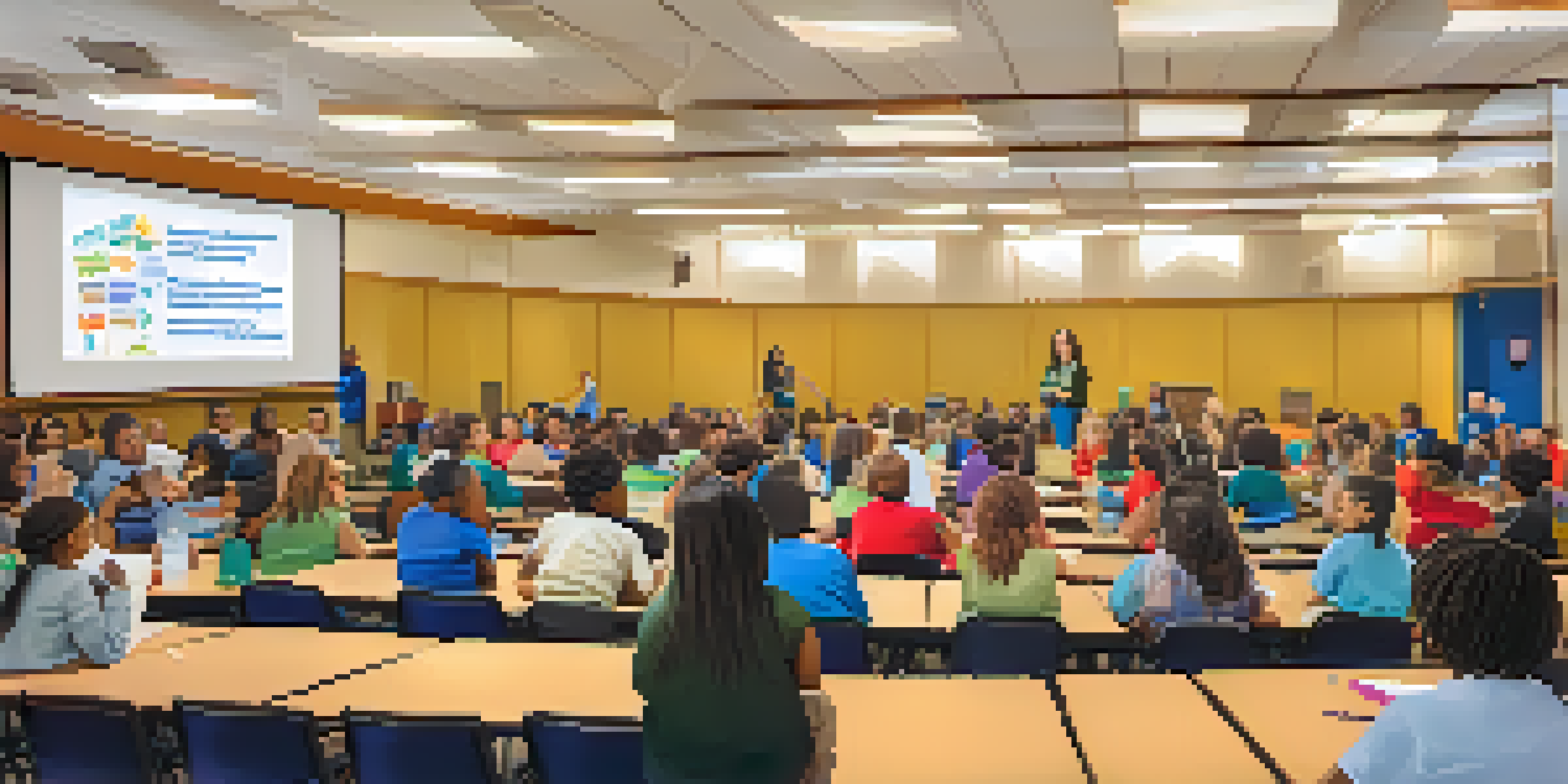The Role of Community Feedback in Curriculum Improvement

Understanding the Importance of Community Feedback
Community feedback serves as a crucial bridge between educational institutions and the people they serve. Engaging with parents, students, and local organizations helps schools understand the needs and expectations of their community. This input is invaluable, as it provides insights that may not be visible from within the school walls.
Education is not preparation for life; education is life itself.
By actively seeking out feedback, educators can make informed decisions that reflect the desires and aspirations of their community. This collaborative approach fosters a sense of ownership among community members, making them feel valued and heard. Ultimately, when people feel involved, they are more likely to support and engage with the school's mission.
Additionally, community feedback can highlight areas needing improvement that might otherwise go unnoticed. For example, if parents express concern about a particular subject's relevance or difficulty, educators can use that information to adjust the curriculum accordingly. This responsive approach leads to a more dynamic and effective educational system.
Methods for Gathering Community Feedback
There are several effective ways to gather feedback from the community, each with its own advantages. Surveys and questionnaires are popular tools, allowing for anonymous input from a broad audience. Schools can distribute these through online platforms, making it easy for busy parents to participate and share their thoughts.

Another effective method is hosting community forums or focus groups. These gatherings can facilitate open discussions, allowing participants to express their opinions in real-time. Such interactions not only yield rich qualitative data but also strengthen community ties by fostering a sense of collaboration.
Value of Community Feedback
Community feedback is essential for schools to understand local needs and improve educational practices.
Additionally, leveraging social media can be an excellent way to engage the community. Educators can create polls or discussion posts on platforms where families are active, encouraging spontaneous feedback. This approach not only increases participation but also demonstrates that the school values the community's voice in shaping the curriculum.
Analyzing and Interpreting Feedback
Once feedback is collected, the next step is to analyze and interpret the data effectively. This process involves identifying common themes and trends that emerge from the responses. For instance, if multiple parents express dissatisfaction with a particular teaching method, it’s essential to explore why that is and how it can be addressed.
The whole purpose of education is to turn mirrors into windows.
Educators should approach this analysis with an open mind, recognizing that feedback may challenge existing practices. It’s crucial to differentiate between constructive criticism and mere complaints, focusing on actionable insights that can lead to meaningful change. This reflective practice is vital in ensuring that feedback is not just collected but utilized effectively.
Collaboration among educators, administrators, and community members during this analysis phase can enhance understanding and acceptance of the findings. By collectively discussing the feedback, stakeholders can develop a shared vision for curriculum improvement, ensuring everyone is on the same page.
Implementing Changes Based on Feedback
Implementing changes based on community feedback requires careful planning and communication. Once educators have identified areas for improvement, they must develop a clear action plan outlining how they will address the concerns raised. This plan should include specific goals, timelines, and responsibilities to ensure accountability.
Transparency is key during this implementation phase. Schools should communicate with the community about the changes being made and the rationale behind them. Regular updates can help maintain trust and engagement, allowing community members to see the impact of their feedback in action.
Effective Feedback Methods
Surveys, forums, and social media are effective tools for gathering community insights and fostering engagement.
Moreover, it’s essential to pilot new initiatives on a small scale before a full rollout. This approach allows educators to assess the effectiveness of the changes and make any necessary adjustments based on ongoing feedback. By being open to iteration, schools can create a curriculum that truly meets the needs of their community.
The Role of Continuous Feedback Loops
Continuous feedback loops are vital in ensuring that curriculum improvements remain relevant and effective. By establishing regular intervals for gathering feedback, schools can stay attuned to the evolving needs of their community. This proactive approach helps educators anticipate challenges and respond more swiftly.
Incorporating feedback into ongoing assessments also allows for a more dynamic curriculum. For example, after implementing a new teaching strategy, educators can survey students and parents to gauge its effectiveness. This iterative process not only enhances learning outcomes but also fosters a culture of improvement within the school.
Moreover, continuous feedback encourages a sense of partnership between the school and the community. When community members see their input valued over time, they are more likely to remain engaged and invested in the educational process. This collaboration ultimately leads to a more enriching experience for students.
Celebrating Successes and Acknowledging Contributions
Recognizing and celebrating successes resulting from community feedback is crucial for maintaining momentum. When schools achieve positive outcomes, whether it’s improved student engagement or successful new programs, it’s essential to share these stories with the community. Celebrating these milestones fosters a sense of pride and accomplishment among all stakeholders.
Acknowledging the contributions of community members who provided feedback is equally important. This recognition can take many forms, from thank-you notes to public acknowledgments during school events. Such gestures reinforce the idea that community input is valued and directly influences positive change.
Continuous Improvement Culture
Establishing continuous feedback loops ensures that curriculum changes remain relevant and responsive to community needs.
Moreover, sharing success stories can inspire further participation in the feedback process. When community members see tangible results from their input, they are more likely to continue engaging with the school. This ongoing dialogue creates a vibrant educational environment where everyone feels responsible for student success.
Future Directions for Community Engagement in Education
Looking ahead, the role of community feedback in curriculum improvement will likely continue to evolve. As technology advances, educators can explore new tools for gathering and analyzing feedback. For instance, utilizing data analytics can help identify patterns in responses, allowing for more informed decision-making.
Additionally, fostering partnerships with local organizations can enhance the feedback process. Collaborating with community groups can provide deeper insights into the needs of diverse populations, ensuring that the curriculum reflects a wide array of perspectives. This inclusivity is crucial in today’s multicultural society.

Ultimately, the future of education hinges on the ability to adapt and respond to the voices of the community. By prioritizing feedback as a foundational element of curriculum development, schools can create dynamic learning environments that meet the needs of all students and prepare them for success in an ever-changing world.